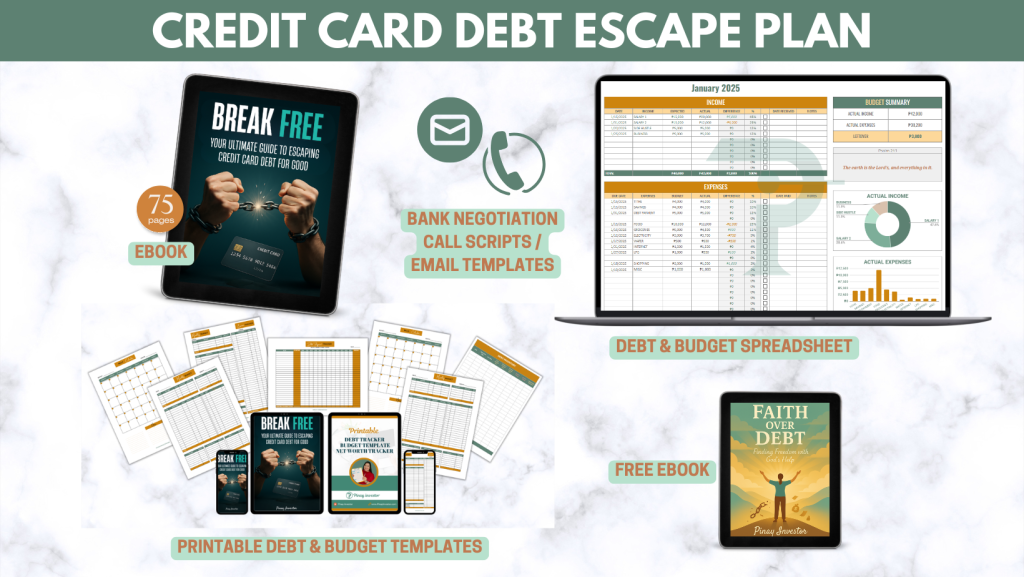You check your credit card bill, breathe out, and think, At least I’m paying on time.
You send the payment for the minimum amount due and feel a bit relieved.
“Okay pa ako,” you whisper. “At least hindi pa ako delinquent.”
For many Filipinos, that small act feels responsible. And yes, technically it is. The bank sees you as a “good payer.”
But here’s the truth most cardholders don’t realize: paying only the minimum is what keeps you trapped.
It’s the reason your balance barely moves, even when you’ve been paying faithfully for months or years.
It’s the reason your next payday always feels short.
And it’s one of the most powerful tools banks use to earn billions—silently, month after month.
What the Minimum Due Really Means
Every billing statement shows a few key numbers: your total balance, your minimum amount due, and your due date.
The minimum due is the smallest amount the bank requires you to pay to avoid penalties. Usually, it’s 3% to 5% of your total balance, or a fixed amount like ₱500–₱850, whichever is higher.
At first glance, it looks manageable. “Kaya ko ‘yan,” you think. “At least hindi ako magiging past due.”
But here’s the problem: that minimum payment is not designed to clear your debt. It’s designed to keep you paying interest for as long as possible.
Let’s break it down.
Say your total balance is ₱40,000 and your bank charges 3% interest per month.
That’s ₱1,200 interest right away.
Your minimum due is ₱2,000.
When you pay it, ₱1,200 goes straight to interest, and only ₱800 goes to your actual balance.
So after paying ₱2,000, you still owe ₱39,200.
Next month, interest is charged again — now on ₱39,200.
This repeats, every month, until one day you realize you’ve paid ₱20,000 already… yet your balance still looks the same.
Read: What Happens If You Stop Paying Your Credit Card Debt in the Philippines?
The Business Model Behind the Trap
Banks know this system works beautifully—for them.
The minimum due gives customers a sense of control while quietly keeping the interest machine running.
Here’s how it benefits them:
| What You Do | What Happens for the Bank |
|---|---|
| Pay only the minimum | They earn interest longer |
| Stay “updated” every month | They keep you as a good customer (with profit) |
| Avoid default | They collect for years without chasing you |
It’s brilliant business psychology.
You feel responsible, they feel secure—and your money keeps flowing to them.
That’s why you’ll notice how friendly and easy it is to pay the minimum. It’s not a coincidence. It’s part of the design.
Why So Many Filipinos Fall for It
You’re not alone. In fact, this is the most common credit card mistake among Filipinos today.
A report from the Bilyonaryo News Channel revealed that credit card debt in the Philippines has reached “critical risk levels,” with balances growing faster than any other type of consumer loan.
That means many of us are swiping to survive—paying for food, tuition, medicine, and emergencies—and covering only the minimum when payday comes.
Culturally, we were taught that as long as you’re paying something, you’re okay.
“Updated naman ako,” we say.
But updated doesn’t mean improving. It just means the interest meter keeps running.
And because the minimum due feels small compared to your full balance, it tricks your brain into thinking you can handle it, until one day, you’re paying five cards at once, and half your salary is gone before groceries.
The Real Cost of the Minimum Payment
Let’s put numbers to it.
If you owe ₱50,000 on your credit card and pay only the 5% minimum (₱2,500 per month):
-
You’ll need over 10 years to fully pay it off.
-
You’ll pay more than ₱80,000 total, with about ₱30,000 going to interest.
Ten years of paying for one balance that never seems to end.
That’s a whole decade of lost opportunities—investments you could’ve made, vacations you could’ve taken, or savings you could’ve built.
So when banks advertise “low minimum payments,” it’s not generosity. It’s a marketing trap that keeps you dependent.
How to Break Free from the Minimum Due Cycle
Escaping the cycle doesn’t require magic. It requires awareness, strategy, and small, consistent steps.
Here’s how to start.
1. Face your real numbers.
Don’t guess your total balance — know it.
List every card you have, their balances, interest rates, and minimum dues.
To make this easier, use my free Debt Inventory Tracker here:
This simple worksheet helps you organize your debt and see how much of your monthly budget goes to interest.
Awareness is your first weapon.
2. Pay more than the minimum, even by a little.
Every extra peso beyond the minimum goes directly to your balance — not interest.
If your minimum due is ₱2,500, try paying ₱3,000.
That ₱500 may seem small, but it shortens your repayment timeline and saves you thousands in interest.
If you can double your payment, even better.
The goal isn’t perfection; it’s progress that actually moves the numbers down.
3. Use a structured payoff method.
There’s no single “best” way to pay off debt, but these two methods work wonders:
-
Snowball Method: Focus on your smallest balance first. Each victory gives you motivation to keep going.
-
Avalanche Method: Focus on the card with the highest interest rate. It saves you the most money overall.
Choose the one that fits your personality. What matters is that you stick with it.
Inside my ebook, Break Free: Your Ultimate Guide to Escaping Credit Card Debt for Good, I explain these and 11 other strategies with real examples for Filipino cardholders.
4. Stop adding new debt while you’re paying off old ones.
Swiping while in debt is like trying to fill a bucket that has a hole at the bottom.
You can’t outpay a habit you keep repeating.
Use cash, debit, or e-wallets while you’re rebuilding your finances.
The goal is to stop the bleeding before you start healing.
5. Talk to your bank before it’s too late.
If you’re struggling to pay, don’t wait for the calls and demand letters.
Call your bank first.
Ask about programs like balance conversion, balance transfer, or restructuring.
These can lower your monthly dues or reduce your interest rate so you can actually breathe.
You can say:
“I want to settle my balance, but I’m struggling with the current interest. Do you have a restructuring plan or balance conversion option?”
A short phone call can save you thousands and give you peace of mind.
Read: Can You Go to Jail for Credit Card Debt in the Philippines?
Why This Step Matters
When you’re stuck paying only the minimum, it feels like progress, but it’s actually financial quicksand. You’re working hard, but the ground keeps pulling you back.
Breaking free from the cycle means choosing long-term peace over short-term relief. It means paying for freedom, not just for survival.
And yes, it’s hard at first. But every small step counts.
The First Step Toward Freedom
If you’re tired of feeling like your salary disappears into payments that never end, start today.
-
Download your free Debt Inventory Tracker to face your numbers with clarity.
-
Read my ebook Break Free: Your Ultimate Guide to Escaping Credit Card Debt for Good — a practical, step-by-step guide for Filipinos who want to pay off credit card debt for good.
You don’t need to be debt-free tomorrow.
You just need to start moving in the right direction—one payment, one decision, one win at a time.



